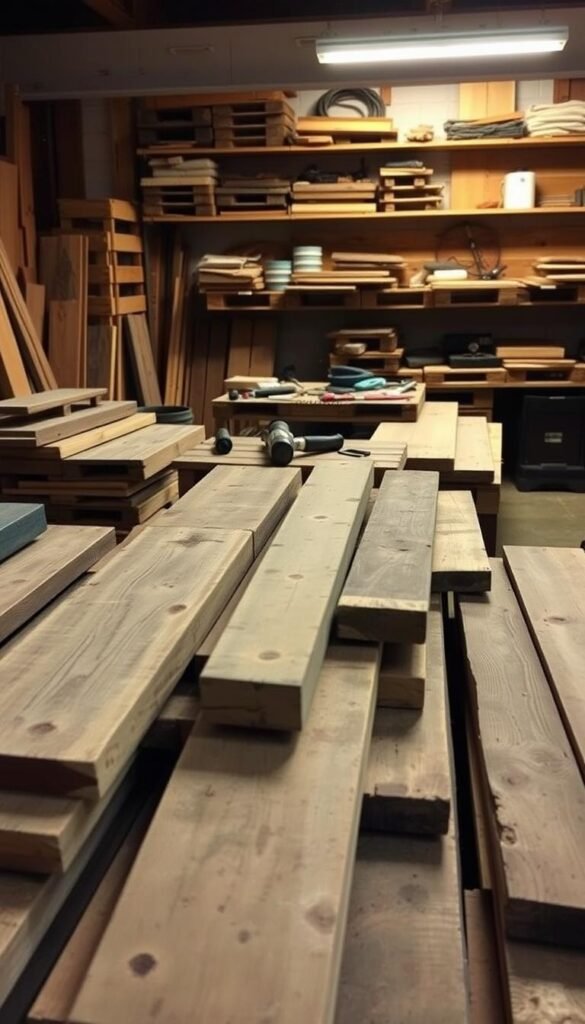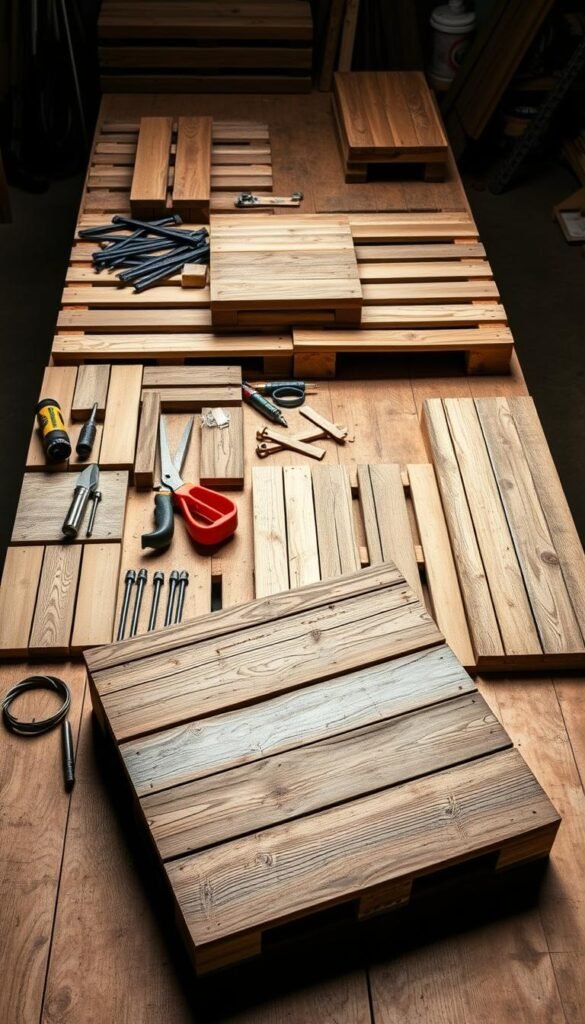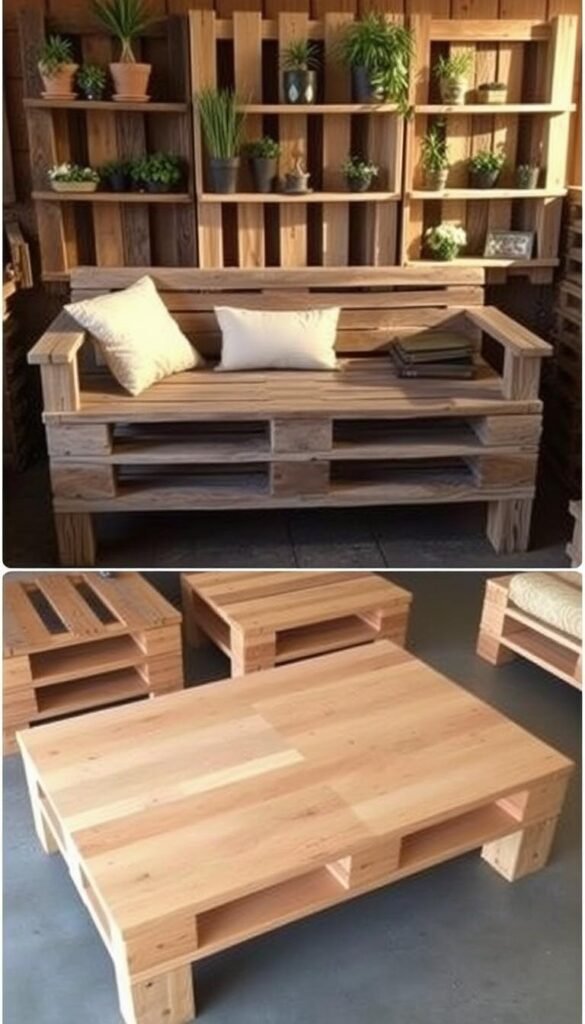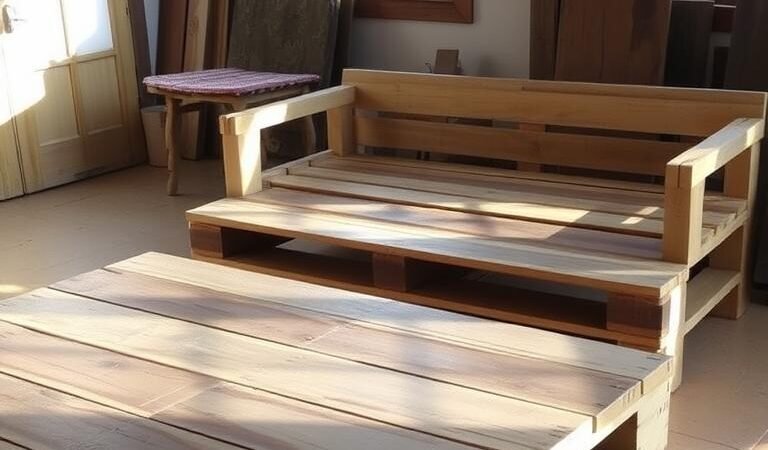Upcycling wooden pallets into stylish furnishings has become a popular trend for crafters and design lovers alike. These versatile materials offer an affordable way to create unique, functional pieces that add character to any space. With some creativity and basic tools, discarded wood transforms into eye-catching furniture.
One enthusiast turned three weathered pallets into a charming centerpiece for their porch. By combining them with scrap lumber, they crafted a sturdy surface with natural imperfections that enhance its rustic appeal. The project cost under $100, proving budget-friendly solutions exist for those willing to explore unconventional materials.
The raw texture of pallet wood pairs beautifully with painted or stained bases, offering endless customization options. Whether designing for indoor lounges or outdoor patios, the right finish ensures durability while maintaining that sought-after handmade charm.
Key Takeaways
- Reclaimed wood projects provide cost-effective alternatives to store-bought furniture.
- Natural imperfections in pallets add distinctive character to finished pieces.
- Custom finishes allow adaptation for both indoor and outdoor use.
- Simple constructions can yield surprisingly professional-looking results.
- Repurposing materials brings environmental benefits alongside creative satisfaction.
Materials and Tools You’ll Need
Transforming discarded pallets into stunning furniture starts with gathering the right materials and tools. Quality supplies ensure durability and ease during construction. Here’s how to prepare for a seamless project.

Finding and Prepping Pallet Wood
Look for HT-stamped pallets (heat-treated) for indoor safety. Avoid chemically treated ones marked “MB.” These stamps are usually on the side of the pallet.
Disassemble carefully using a duckbill deck wrecker or crowbar. Wear goggles and a dust mask—nails and splinters are common. Sand or plane boards to smooth rough edges.
Essential Tools for the Project
Power tools save time, but manual options work for tighter budgets. Below is a comparison:
| Tool | Power Option | Manual Alternative |
|---|---|---|
| Cutting | Circular saw | Hand saw |
| Joining | Kreg Jig | Hammer & nails |
| Sanding | Power sander | Sandpaper block |
For structural support, use 4×4 lumber for legs and 3″ deck screws. A miter saw ensures precise angles.
Optional Finishes and Customizations
Choose a finish based on location and style:
- Outdoor: Polyurethane for weather resistance.
- Rustic: Wire-brushed texture with milk paint.
- Modern: Glass tops ($100 average) for sleek contrast.
Add Shepherd Hardware casters for mobility. Check Facebook Marketplace for free pallets or discounted lumber.
Step-by-Step Construction Guide
Crafting furniture from reclaimed wood requires careful preparation and precise assembly techniques. Follow this guide to ensure your creation stands the test of time while reflecting your unique style.

How to Disassemble and Clean Pallets
Start by prying apart boards using a wedge-and-pry bar. Work slowly to minimize splintering—wearing gloves protects hands from rough edges. Remove nails with a claw hammer, then sand surfaces until smooth.
For stubborn planks, a rubber mallet helps loosen joints without damaging wood. Brush away sawdust and wipe with a damp cloth to reveal the natural grain.
Building the Base: Legs and Frame
Cut 4×4 posts to 19″ for standard coffee table height. Secure them to a rectangular frame using 3″ deck screws. Pre-drill holes to prevent splitting.
For stability, angle brackets reinforce corners. Hairpin legs offer a mid-century twist, while gabion bases—filled with pebbles—add industrial flair.
Attaching the Tabletop or Bench Seat
Arrange boards with ¼” gaps for seasonal expansion. Pocket holes create invisible joints, or use decorative brackets for a rustic look. Check dimensions against templates (48″×24″ for coffee tables).
If warping occurs, clamp boards overnight before fastening. For more design ideas, explore budget-friendly outdoor transformations.
Design Variations and Creative Touches
Personalizing reclaimed wood creations unlocks endless design possibilities for any space. Whether aiming for farmhouse warmth or industrial edge, small details transform basic structures into focal points. The right finish or functional add-ons ensure pieces align with your lifestyle and decor.

Indoor vs. Outdoor Furniture Considerations
For outdoor projects, exterior-grade polyurethane shields against rain and UV rays. Teak oil offers a natural alternative—its golden hue deepens over time. Indoor pieces benefit from matte varnishes that highlight wood grain without glare.
Rustic lovers might leave cracks for character, while modern designs demand seamless tabletops. Always check wood for splinters before bringing pieces inside.
Adding Wheels, Glass Tops, or Paint
Locking casters make heavy items mobile—ideal for rearranging spaces. Frosted glass inserts add sophistication and protect surfaces. For bold contrast, paint bases in cherry red or lemon yellow while keeping wood tops natural.
Epoxy resin pours create durable, glossy finishes. Mosaic tile inlays introduce color without overwhelming the pallet furniture aesthetic.
Matching Sets: Coffee Table and Bench
A 48″ bench with a 15″ seat height pairs perfectly with a same-height coffee piece. Repeat design elements like chamfered edges or matching stains for cohesion. Modular sets allow flexible arrangements—ideal for compact homes.
For storage, consider flip-top benches with hidden compartments. USB charging stations built into tabletops blend vintage charm with modern convenience.
Conclusion
Breathing new life into reclaimed materials offers both eco-friendly and budget-conscious rewards. For under $150 and a weekend’s effort, these projects deliver unique furniture with character—far cheaper than $500+ retail alternatives.
Start with a small side table to hone skills before tackling larger pieces. The weathered textures of pallet wood adapt effortlessly, whether styled for farmhouse warmth or industrial edge.
Always sand thoroughly and seal surfaces for safety. Well-built creations last 3+ years—pair them with matching trays or coasters for cohesion. Share your finished coffee table or bench online to inspire others!
Every handcrafted piece proves great design needn’t break the bank. With patience and creativity, anyone can craft functional art.
